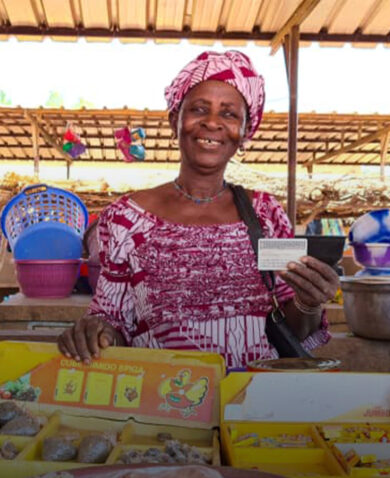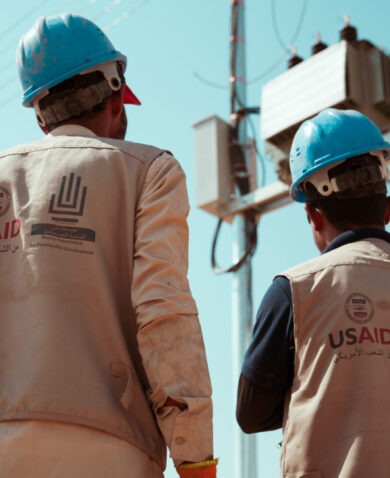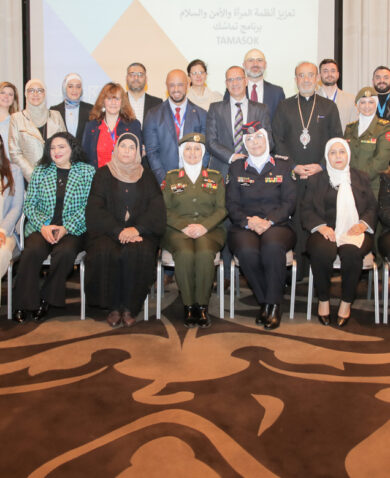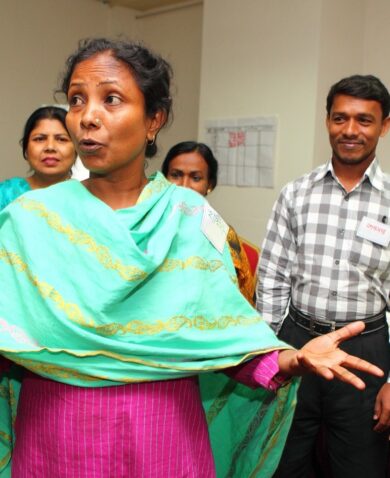
Applying the ‘Do No Harm’ Principle Through Informed Consent
November 21, 2023 | 3 Minute ReadHere are our recommendations on how to apply informed consent in complex environments, such as fragile and conflict-affected settings.
Chemonics implements international development programs in a variety of sectors across the world, very often among communities that live in fragile and complex environments. Under such circumstances, communities are often wary of participating in surveys and data collection as this may expose them to intimation, discrimination, or violence. At the same time, collecting data remains vital to learning, adaptation, and the implementation of results-driven programs.
The gathering of information should be done with conflict sensitivity to minimize the negative impact (such as being persecuted for one’s political opinion) that the presence of programs and their staff may have among communities. Chemonics strives to achieve this by applying the Do No Harm framework to its data collection methods across our programs. This starts with the ethical application of informed consent, which includes “the research procedure, their purposes, risks and anticipated benefits, alternative procedures (where therapy is involved), and a statement offering the subject the opportunity to ask questions and to withdraw at any time from the research.”
Sudan provides one such example. The Sudan Armed Forces and the paramilitary group of Rapid Support Forces are fighting for control, resulting in heavy civilian causalities and the breakdown of democratic processes and institutions. The Sudan Transition Program (STP), funded by USAID’s Office of Transition Initiatives (OTI) and implemented by Chemonics, regularly conducts public opinion surveys related to prevailing media narratives in Sudanese media outlets. Gathering data on attitudes, behaviors, and perceptions related to media messages in Sudan is highly sensitive, especially now. The program applies the Do No Harm framework by adapting the Informed Consent processes to the risks and needs of their respondents in ensuring protection and participation are applied intentionally.
Based on the experience of STP and our other programs in fragile and conflict-affected settings, here are a few recommendations for implementing informed consent in challenging environments:
- Informed consent should be flexible and adapted to the context. In complex environments where data collection needs to take place, informed consent can be a multifaceted process that demands careful consideration on a case-by-case basis. For example, due to the high risk and personal safety issues in Sudan, respondents are given the option of verbal informed consent – as opposed to providing their signature – to encourage their participation in surveys.
- One-on-one interviews are safer. While time-consuming, one-on-one interviews (such as Key Informant interviews) are considered safer than focus groups for respondents in complex situations and have made possible the collection of more authentic insights on sensitive issues related to individual opinions and behaviors.
- Transparent communication is key to obtaining informed consent. Project teams ensure that the informed consent form contains enough detailed information in the respondents’ native language, so they properly understand the purpose of interviews and their rights. Informed consent should explain to participants the reason they were selected, potential risks for participating, benefits, alternative options, local contact for questions, and provide the option of withdrawal without consequences.
- Respect confidentiality. During the informed consent process, it is crucial to not collect individual details that could enable the identification of respondents. For STP, they take careful steps not to include personally identifiable information during data collection. For example, in instances where we need to provide stipends to participants, the use of digital tools like QR codes, instead of personal IDs, has been useful.
- Maintain ethical standards at all times. Prioritizing people’s well-being above the need for data is a necessity in applied research. When designing and planning for data collection, weigh out whether the research introduces risks to participants, if and how the risks can be mitigated, and whether the benefits outweigh the risks or not. Developing comprehensive protocols for data collection keeps the process ethical, whether data collection is taking place in person or remotely. Subsequent training of data collectors on informed consent and data collection and putting in place monitoring compliance procedures (such as regular audits) on protocol application is also crucial in ensuring the research design and implementation is ethical and follows the Do No Harm framework throughout the cycle of research (design, data collection, data analysis, dissemination).
- Adapting to an evolving environment is a necessity. Using adaptive data collection methods that reflect the concerns and needs of respondents encourages participation from local communities. It is important to keep brief notes on how respondents’ behavior changes during the interview to understand how they are being affected by the survey. Such observations should be discussed with the entire research team regularly and be addressed in a timely manner.
Intentional and conflict-sensitive informed consent involves many considerations and takes time to plan well. The implications should be weighed when deciding what informed consent will look like for your data collection needs. Doing so facilitates authentic data collection which contributes to the overall success of a project’s activities as they will be well-informed, inclusive, and responsive to the needs of the people and communities they are meant to serve.
How does your organization navigate the complexities around informed consent and applied research?
Banner image caption: The Pyramids of Meroë in Kabushiya, Sudan.
Posts on the blog represent the views of the authors and do not necessarily represent the views of Chemonics.

























